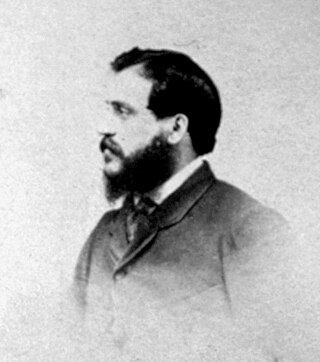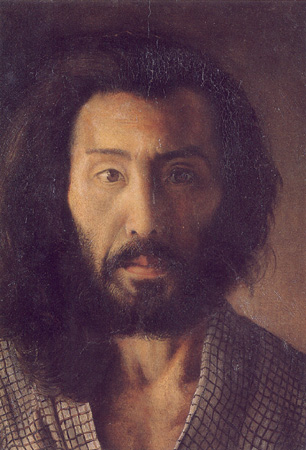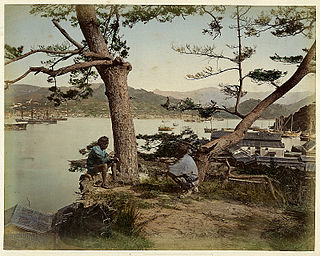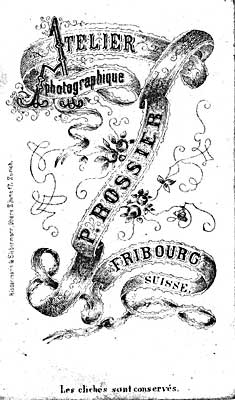Related Research Articles
Photography in China dates back to the mid-19th century with the arrival of European photographers in Macao. In the 1850s, western photographers set up studios in the coastal port cities, but soon their Chinese assistants and local competition spread to all regions.

Kusakabe Kimbei was a Japanese photographer. He usually went by his given name, Kimbei, because his clientele, mostly non-Japanese-speaking foreign residents and visitors, found it easier to pronounce than his family name.

Adolfo Farsari was an Italian photographer based in Yokohama, Japan. His studio, the last notable foreign-owned studio in Japan, was one of the country's largest and most prolific commercial photographic firms. Largely due to Farsari's exacting technical standards and his entrepreneurial abilities, it had a significant influence on the development of photography in Japan.

The firm of Stillfried & Andersen, also known as the Japan Photographic Association, was a photographic studio founded by Baron Raimund von Stillfried and Hermann Andersen that operated in Yokohama, Japan between 1876 and 1885. The studio is noted for its portraits and landscapes that were often hand-coloured and presented in bound albums. The firm also produced photographic prints from negatives by Felice Beato.

Felice Beato, also known as Felix Beato, was an Italian–British photographer. He was one of the first people to take photographs in East Asia and one of the first war photographers. He is noted for his genre works, portraits, and views and panoramas of the architecture and landscapes of Asia and the Mediterranean region. Beato's travels gave him the opportunity to create images of countries, people, and events that were unfamiliar and remote to most people in Europe and North America. His work provides images of such events as the Indian Rebellion of 1857 and the Second Opium War, and represents the first substantial body of photojournalism. He influenced other photographers, and his influence in Japan, where he taught and worked with numerous other photographers and artists, was particularly deep and lasting.

Yokoyama Matsusaburō was a pioneering Japanese photographer, artist, lithographer and teacher.

Uchida Kuichi was a pioneering Japanese photographer from Nagasaki. He was greatly respected as a portrait photographer and was the only photographer granted a sitting to photograph the Emperor Meiji.

Pierre Joseph Rossier was a pioneering Swiss photographer whose albumen photographs, which include stereographs and cartes-de-visite, comprise portraits, cityscapes, and landscapes. He was commissioned by the London firm of Negretti and Zambra to travel to Asia and document the progress of the Anglo-French troops in the Second Opium War and, although he failed to join that military expedition, he remained in Asia for several years, producing the first commercial photographs of China, the Philippines, Japan and Siam. He was the first professional photographer in Japan, where he trained Ueno Hikoma, Maeda Genzō, Horie Kuwajirō, as well as lesser known members of the first generation of Japanese photographers. In Switzerland he established photographic studios in Fribourg and Einsiedeln, and he also produced images elsewhere in the country. Rossier is an important figure in the early history of photography not only because of his own images, but also because of the critical impact of his teaching in the early days of Japanese photography.

Baron Raimund von Stillfried, also known as Baron Raimund von Stillfried-Rathenitz, was an Austrian military officer and early professional photographer in Japan. His historical photographs of Japan following the end of the Tokugawa shogunate in the 1870s have been appreciated for their documentary and artistic value and collected in international archives.
Tong Cheong was a Chinese photographer who operated in Yokohama, Japan in the 19th century. Cheong advertised his services as a printer and photographer in the 1884 Japan Directory, offering souvenir albums of the "views and costumes" of Japan. The 1885 advertisement for his business, now called Tong Cheong Brothers, has no mention of photography, simply noting services as printers and bookbinders. Following a period in which many foreign photographers were living and working in Japan, by the end of 1886 Tong Cheong and Adolfo Farsari were the only foreign commercial photographers still operating in the country. By the following year Cheong had left Japan.
Ukai Gyokusen was a pioneering Japanese photographer. Although he is much less well known than his contemporaries Shimooka Renjō and Ueno Hikoma, he is important for being the first Japanese professional photographer, having established a photographic studio in Edo in 1860 or 1861.

Shimooka Renjō was a Japanese photographer and was one of the first professional photographers in Japan. He opened the first commercial photography studio in Yokohama, and in Japan he is widely considered the father of Japanese photography.

Suzuki Shin'ichi was the older Japanese photographer of that name.

Tomishige Rihei was an important 19th and early 20th century Japanese photographer. He was a pioneer of wet-plate photography in Japan and was noted for his excellent large-format, albumen landscapes. Tomishige is especially renowned in Kyūshū.
Suzuki Shin'ichi was the younger of two Japanese photographers to bear that name.

The Far East was a newsmagazine published by J. R. Black in Yokohama, Japan between 1870 and 1878. The periodical was illustrated with original, pasted-in photographs, at a time when photomechanical reproduction was still in its infancy. During its run, The Far East published approximately 750 photographs, mostly of Japan and China, by at least 20 different photographers.
John Reddie Black was a Scottish publisher, journalist, writer, photographer, and singer. Much of his career was spent in China and Japan where he published several newspapers including The Far East, a fortnightly newsmagazine illustrated with original photographs.
Kameya Tokujirō was a Japanese photographer. Kameya's original surname was Abe ; he was adopted by a family named Kameya. He learned photography at Deshima, the Dutch enclave in the harbour of Nagasaki where physicians Jan Karel van den Broek and J. L. C. Pompe van Meerdervoort taught photography in addition to medicine and chemistry. In turn, Kameya taught photography to Tomishige Rihei, who became his apprentice in 1862. The same year, Kameya moved to Kyoto to open a photographic studio – the first commercial studio in the city. In 1868, he returned to Nagasaki, where he operated a studio until his death. He died in 1884 in Vladivostok, having opened a branch studio there.

Shima Kakoku was a pioneering Japanese photographer and artist. He was born in modern-day Tochigi Prefecture. Possibly inspired by his father, who was an avid painter, in 1847 he entered an art school in Edo where he met Ryū, a fellow student. The two married in 1855 and soon began moving about the Kantō region, possibly exhibiting their works along the way. At this time Shima seems to have had some pictures published as book illustrations. At some point the couple learned photography, and in the spring of 1864 Ryu photographed Kakoku, thereby creating the earliest known photograph by a Japanese woman. A wet-plate print of this portrait remains in the Shima family archives. The Shimas operated a photographic studio in Edo in about 1865 to 1867, until Kakoku accepted a teaching position at Kaiseijo. Later, Shima worked at Daigaku Tōkō, and while there invented the first Japanese movable type, for the printing of medical textbooks. Shima Kakoku died in 1870, and his wife returned to Kiryū where she opened her own photographic studio.
Orrin Erastus Freeman (1830–1866) was an American professional photographer in China and Japan. Freeman worked in the ambrotype process.
References
- Bennett, Terry. Old Japanese Photographs: Collector's Data Guide London: Quaritch, 2006. ISBN 0-9550852-4-1 (hard)
- Bennett, Terry. Photography in Japan: 1853–1912 Rutland, Vermont: Charles E. Tuttle, 2006. ISBN 0-8048-3633-7 (hard)